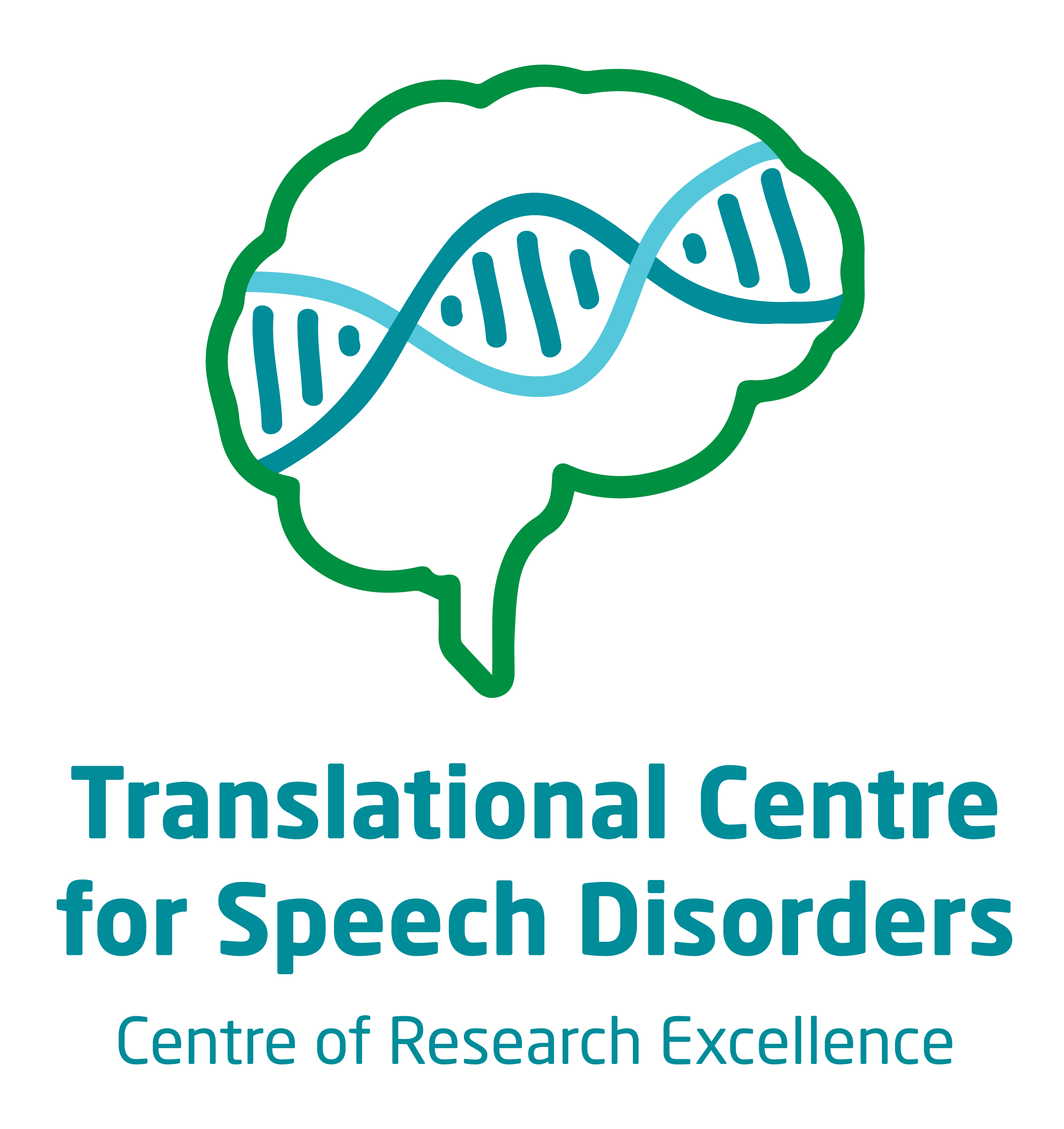GRIN2A
What are GRIN2A-related speech disorders and epilepsy?
GRIN2A-related speech disorders and epilepsy are characterised by speech and language disorder and epilepsy. The clinical spectrum is very broad, ranging from mildly affected to severe encephalopathy.
Individuals with GRIN2A-related speech disorders and epilepsy have impairments in their speech and language. They may have difficulty understanding language (receptive language impairment) or using language to express themselves (expressive language impairment). Their speech may also be unclear due to difficulty controlling the muscles for speech (dysarthria) or difficulty planning movement of the lips, tongue and other articulators to produce sounds and syllables precisely and consistently (speech dyspraxia).1
Most individuals with GRIN2A-related speech disorders and epilepsy also have epilepsy.2 Seizures typically start between three and six years of age, although they can start at any time between infancy and adolescence. Children with GRIN2A-related speech disorders and epilepsy most commonly have focal seizures, and abnormal electrical activity in the brain becomes more frequent in sleep. Some individuals with severe epilepsy have near-continuous epileptic activity in sleep (called continuous spike-and-wave in sleep).
Epilepsy syndromes include: Landau-Kleffner syndrome (LKS), epileptic encephalopathy with continuous spike-and-wave during sleep (ECSWS), childhood epilepsy with centrotemporal spikes (CECTS), atypical childhood epilepsy with centrotemporal spikes, autosomal dominant rolandic epilepsy with speech dyspraxia (ADRESD), and infantile-onset epileptic encephalopathy. Up to 20% of individuals with these epilepsy syndromes (called the epilepsy-aphasia spectrum syndromes) have disease-causing changes in the GRIN2A gene.
Contact
For further information, do get in touch with the CRE Speech and Language team at:
Email: geneticsofspeech@mcri.edu.au
Phone: (03) 9936 6334
Frequently asked questions
Individuals with severe epilepsy experience loss of previously learnt skills (called regression). In LKS this regression is generally restricted to regression of language skills, but in ECSWS regression can also affect behaviour, learning, memory, and attention, motor and social skills.3
Almost two thirds of individuals with GRIN2A-related speech disorders and epilepsy have intellectual disability/developmental delay, which ranges from mild to severe.4 Just over one quarter of individuals have low muscle tone or ‘floppy muscles’ (known as hypotonia). Others have difficulty moving due to loss of muscle coordination (ataxia), stiff and jerky muscle (spasticity) or involuntary jerking or twitching (chorea).4 Some individuals have difficulty moving their lips and tongue, may experience trouble during mealtimes with chewing or food ‘getting stuck’ or have difficulty controlling their saliva.1 These impairments are often mild. Some individuals will also have attention deficit hyperactivity disorder, autism spectrum disorder, schizophrenia, anxiety or another behavioural or psychiatric condition.4
The age of development of first words depends on the type of epilepsy syndrome that the child has. Some children will develop first words around one year of age, while others start talking later. In rare cases, some children with GRIN2A-related speech disorders and epilepsy will not develop speech.5
Individuals with GRIN2A-related speech disorders and epilepsy often have speech that is difficult to understand, and the majority of cases studies to date have mild-moderately impaired speech.1 Individuals with GRIN2A-related speech disorders and epilepsy may substitute or omit sounds or syllables. Their speech may sound slow, and they may have short phrases or emphasise the wrong parts of speech. Their voice may sound hoarse, harsh or breathy. They may also have nasal-sounding speech.
We don’t yet know how speech develops over time. In the most comprehensive speech study to date, young adults (aged 16-20 years) generally had more impaired speech compared to older adults (aged 24 years and older).1 This may indicate that speech improves over time, however we need to study larger numbers of individuals with GRIN2A-related speech disorders and epilepsy to confirm this.
Some individuals with GRIN2A-related speech disorders and epilepsy attend mainstream school, some attend specialist school and some have a dual enrolment where they spend part of each week at a mainstream school and part at a specialist school.
There is no research on speech and language interventions that are specifically designed for GRIN2A-related speech disorders and epilepsy.
There is good evidence from speech therapy trials that Rapid Syllable Transition (ReST) treatment and the Nuffield Centre Dyspraxia Programme improve speech accuracy in individuals with speech dyspraxia who don’t have other impairments (eg. dysarthria, intellectual disability etc).6
There is some evidence that therapies targeting breath support for speech may improve speech intelligibility and voice quality in individuals with dysarthria.7
In some individuals with GRIN2A-related speech disorders and epilepsy such as those with CECTS, seizures may improve or stop in adolescence. All of the adolescents and young adults in our study (aged 16-24 years) had stopped having seizures, including individuals with ECSWS and ADRESD.1 They continued to have difficulties with speech and language, and most had moderately impaired speech as well as moderate-severe receptive and expressive language impairments.
Similar speech features were noted across all the individuals in one detailed study, who ranged in age from 16 to 64 years.1 The speech of the young adults was more impaired and difficult to understand, which may have been related to their age or the type of epilepsy they had.
Longitudinal data on the same individuals is severely lacking, however data on one individual with ADRESD revealed speech that was slow, effortful and at times unintelligible at 5 years of age.8 He had abnormal fluency, accuracy and rate of speech. At 24 years of age, his speech had improved to be only mildly impaired by comparison to his earlier presentation,1 however he continued to have imprecise articulation, slow speech rate, stress errors and his speech had a harsh and breathy quality. His receptive language skills improved from 5 to 24 years of age, with receptive vocabulary and grammar in the average range. He continued to have difficulties with his expressive language skills.
We need to do more research to understand how speech and language may change across the lifespan for individuals with GRIN2A-related speech disorders and epilepsy.
For information and support on childhood apraxia of speech: https://www.apraxia-kids.org
References
- Turner, S.J., Mayes, A.K., Verhoeven, A., Mandelstam, S.A., Morgan, A.T., & Scheffer, I.E. (2015). GRIN2A: An aptly named gene for speech dysfunction. Neurology, 84(6), 586-593.
- Myers, K.A., & Scheffer, I.E. (2016). GRIN2A-Related Speech Disorders and Epilepsy. GeneReviews.
- Roulet Perez, E., Davidoff, V., Despland, P.A., & Deonna, T. (1993). Mental and behavioural deterioration of children with epilepsy and CSWS: acquired epileptic frontal syndrome. Developmental Medicine and Child Neurology, 35(8), 661-674.
- Strehlow, V., Heyne, H.O., Vlaskamp, D.R.M., Marwick, K.F.M., Rudolf, G., de Bellescize, J., Biskup, S., Brilstra, E.H., Brouwer, O.F., Callenbach, P.M.C., Hentschel, J., Hirsch, E., Kind, P.C., Mignot, C., Platzer, K., Rump, P., Skehel, P.A., Wyllie, D.J.A., Hardingham, G.E., van Ravenswaajj-Arts, C.M.A., Lesca, G., Lemke, J.R. & GRIN2A study group. (2019). GRIN2A-related disorders: genotype and functional consequence predict phenotype. Brain, 142(1), 80-92.
- Pierson, T.M., Yuan, H., Marsh, E.D., Fuentes-Fajardo, K., Adams, D.R., Markello, T., Golas, G., Simeonov, D.R., Holloman, C., Tankovic, A., Karamchandani, M.K., Schreiber, J.M., Mullikin, J.C., Tifft, C.J., Toro, C., Boerkoel, C.F., Traynelis, S.F., Gahl, W.A. (2014). GRIN2A mutation and early-onset epileptic encephalopathy: personalized therapy with memantine. Annals of Clinical and Translational Neurology, 1(3), 190-198.
- Murray, E., McCabe, P., & Ballard, K.J. (2015). A Randomized Controlled Trial for Children With Childhood Apraxia of Speech Comparing Rapid Syllable Transition Treatment and the Nuffield Dyspraxia Programme-Third Edition. Journal of Speech Language and Hearing Research, 58(3), 669-686.
- Pennington, L., Parker, N.K., Kelly, H., & Miller, N. (2016). Speech therapy for children with dysarthria acquired before three years of age. Cochrane Database Systematic Review, 18, 7:CD006937.
- Scheffer, I.E., Jones, L., Pozzebon, M., Howell, R.A., Saling, M.M., & Berkovic, S.F. (1995). Autosomal dominant rolandic epilepsy and speech dyspraxia: a new syndrome with anticipation. Annals of neurology, 38(4), 633-642.






